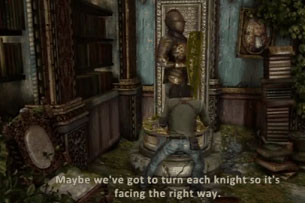Author: [Redacted]
One of the most difficult challenges to designing dungeons, traps, and problems for players to overcome is in creating puzzles that are both interesting, stimulating, and solvable. Players won’t appreciate the puzzles that are too simple or too difficult. Unfortunately due to their time consuming and difficult-to-design nature, many problem solving traps might begin to feel repetitive as DMs fall back on the classics time and again. Fortunately it’s easier than ever to spice things up by drawing inspiration from a variety of sources such as video games, books, and websites.
Spoiler Alert: This article contains a puzzle solution from the Uncharted video game series. If you are playing through the games (or will be) take care when reading this article.

Before getting into where to draw inspiration from when creating puzzles, it’s important to follow a few basic principles of dungeon design when creating puzzles. Following these simple rules will ensure that the puzzles are fun, entertaining, and manageable.
- Keep it easy: Puzzles should be simple to do. Not so simple that it doesn’t present a challenge, because the challenge is part of the fun. However, while most players are intelligent, unless they’re a genius puzzles shouldn’t involve complex mathematical formulas or scientific knowledge.
- When it can’t be easy, make it optional: If for some reason a puzzle or obstacle or trap must be difficult, then make a way around it that the players can find as well. This way if they are unable to solve the problem, they can find a bypass for it instead. Nothing would kill the game faster than for the party to be stuck on an insolvable problem.
- Make them Relatable: Tailor your puzzles and challenges toward the players, characters, and the world they’re a part of (D&D, pathfinder, etc.). A puzzle relating to the presidents of the United States doesn’t really have any business being in a medieval fantasy setting or a galactic space theme. They should also be relatable to the character or quest in some way that the character / player can understand or be invested in. Rather than simply putting the character in a room with all the proper tools and going “solve this”, the puzzle should invest the player in the game.
- Purposeful: The puzzle needs to have a good reason to be there; a goal for its existence. An ancient civilization doesn’t put a mysterious puzzle to guard the door to the local prayer room. That would be irritating on a daily basis for the NPCs going to pray and let’s face it, it’s irritating for the players themselves to solve some monumental puzzle only to find an altar on the other side of the door that just wasted their time getting past.
- Visual and Tactile: Use visual cues and drawings or have actual physical puzzle clues. For example, if a puzzle requires that the players rotate statues, having a clue sheet with hints at the directions the statues should be facing, a map of the room, and say 4 distinct miniatures that they can rotate makes it easier for the players to visualize the problem and enact a solution. Be creative.
While the rules are simple, the challenge then for a GM becomes where to find puzzles that can be adapted. Inspiration for puzzles can come from a variety of sources. From books to movies, video games, and anime. For this particular article, we’ll take a look at video games and their incorporation.



Video Games
While there are a wide array of video games on the market that fall under Puzzling Solving, not all of them are probably good candidates. Games like Catherine, which are great in their own right, feature simplistic block moving puzzles. Despite that these games might be amusing, it would be incredibly difficult to construct that for players to try to maneuver through. Thankfully there are plenty of other games may provide DMs with the kinds of puzzles that can be adjusted to fit into a roleplaying world. These include games like Legend of Zelda, Tomb Raider, Prince of Persia, Indiana Jones, Adam’s Ventures, and the Uncharted series.

One of the most interesting puzzle solving, action and adventure series is the Uncharted Series. There are four games absolutely filled with interesting clues, puzzles, and content that are sure to provide ideas and allow for easy conversation into a roleplaying environments. The above example provided with the rules was taken from the Uncharted series. Another example would be the Semita Solis puzzle that also appears in the series.
In this puzzle, the player comes across a set of rune switches on the floor that must be triggered in a specific order to reveal the doorway. There is no punishment for being wrong, nothing happens. This is an easy enough concept to draw a series of symbols onto a grid paper room. The player has a clue that indicates for them how to go about figuring out the path. It’s easy enough to allow the player to draw a line of the path they follow or to move a miniature along the map. And the GM can indicate any way they choose (say a reset click if they misstep?) that the player has made an error or seems to have chosen a correct grouping of steps.
 Here is the clue the player is provided in the game:
Here is the clue the player is provided in the game:
This clue can be given to the player in any fashion that the GM feels is appropriate for the story line. For example, perhaps the clue is gathered after a battle and was among the things of the person defeated. Or maybe parts of the clue are etched on various walls in rooms within a mysterious temple and the puzzle is in the very last room that protects a sacred treasure.
Change the symbols up to match it to other story elements or the holy symbols of a particular god. Have it spell out a particular phrase that happens to be a magical incantation or the prayer of a specific religion that the group has heard multiple times in the course of the game.

For the record, here is the solution to that particular puzzle:
It demonstrates easily how the GM can make a key to their trick, trap, or puzzle. Many of the puzzles from the Uncharted series would be easy enough to convert into something players can participate with in a roleplaying environment. The wide array of them feature detailed maps, clues, and solutions that make things a little easier on the GM to come up with effective ideas. Part two of this article will cover some wonderful books and web resources specifically for gamers to create exciting dungeons.


